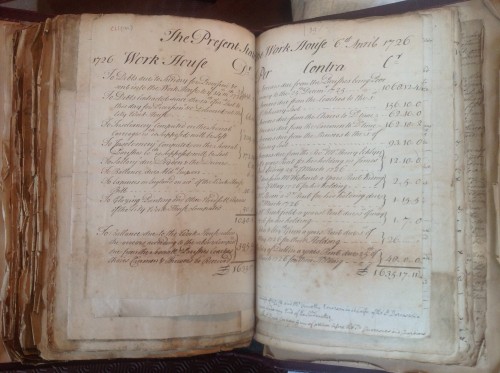A glance at the Dublin workhouse, March 1726
Published in 18th-19th Century Social Perspectives, 18th–19th - Century History, Blogging Irish HistoryThe Lockout centenary inevitably focuses attention on Dublin’s tenement slums, but urban poverty is nothing new. Amongst the copious holdings of Marsh’s LIbrary are a small collection of papers relating to one of the less salubrious institutions of eighteenth-century Dublin: its workhouse (MS Z.3.1.1, 143-55).
The original Dublin workhouse was built in 1705 to tackle the increasing numbers of the poor, from Dublin and elsewhere, who were to found on the streets of the growing capital. It was located in Mount Brown, south of the River Liffey between the Royal Hospital at Kilmainham and the modern location of James’ Hospital (across the road from ‘Murdering Lane’). But it was beset by financial problems from the outset. As early as May 1706 concerns were being raised that the parish churchwardens who were supposed to provide at least some monies were remiss in doing so. Prior to the creation of the workhouse, charity was the responsibility of individual parishes; it is tempting to think that after the establishment of the workhouse, the city parishes may have assumed that poverty was a problem for others to tackle.
There were attempts at solutions. Some of the workhouse’s income came from cloth processing; in November 1706 it could at least pay the wages of its manager. But it could be made more profitable, in a manner that might help its inmates. According to John Vernon, writing to Archbishop King in July 1708, ‘the poor must eat whether they work or no, but being employed, their work feed themselves and many others too’. But little seems to have come of this. In June 1710 the workhouse was still in arrears. The implications of this ongoing problem can be guessed at from a list of its occupants. As of 20 March 1726, it held 222 inmates, from virtually every parish in the city. 97 were male, with the remaining 125 female. Their ages range from 5 to 90, with the higher and lower age groups making up most of the inmates: 111 were under the age of 15, and 60 were over the age of 50 (the sheer number of children in the workhouse was highlighted by no less than Jonathan Swift). The reasons for their admission were listed as, variously, ‘superannuated’, ‘infirm’, ‘bedrid’, ‘king’s evil’ (scrofula), ‘mad’, ‘fools’, ‘blind’, ‘dumb’, ‘fits’, ‘lame’, ‘washers’, ‘sound children’ (there were 93 in the last category, which was by far the largest). Some were detained for combinations of these problems, though no reason was given for the admission of John Howard, aged 34, other than that he was, or had been, a ‘schoolmaster’. The list gives little indications as to the human stories that lay behind the names, but hints of tragedy come through. What is one to make of the admission of John Dunn, aged 8 and ‘infirm’, or Jane Meredith, aged 13 and afflicted by ‘the evil’?
Less then three weeks later, the inhabitants of the workhouse had been reduced to 211, but even those who remained were in a precarious position thanks to the perennial lack of funds. A list of ‘observations on the present state and condition of the workhouse, 6 April 1726’ wearily refers to ‘the usual deficiences in the parish money for several years past’. It was in arrears to the tune of £1,635, and was owed £1,040, mainly from the city parishes, but also from licences granted to coaches, chairs, carmen, brewers, and various rentals that were supposed to supply funds to the workhouse. The money was owed by ‘such as are able to pay but several of those tell us they don’t think themselves obliged to pay now that the act is expired, and do at present actually refuse it, so that notwithstanding such money be legally due from such solvent persons, yet we are at a loss how to recover it, and fear it will not be done without a good deal of trouble and expense’.
By 1750 the Dublin workhouse was essentially a foundling hospital, having never overcome the problems of finance and mismanagement that had beset it from the start. The South Dublin Union would eventually be built in an adjacent location to the original workhouse, but the manuscripts in Marsh’s Library offer a tantalising glimpse of the realities of life on the other side of Georgian Dublin’s ‘Gorgeous Mask’.
John Gibney was recently Muriel McCarthy Research Fellow at Marsh’s Library. Document image reproduced with the permission of the Governors and Guardians of Marsh’s Library.


















Exceptionally interesting short article
Well I searched for the article title and discovered this, great read
Terrific piece, I loved the communications service monitors part
Saved as a favorite, brilliant site!